
The Bajrakli Mosque is a mosque in Belgrade, the capital of Serbia. It is located in Gospodar Jevremova Street in the neighbourhood of Dorćol. It was built around 1575, and is the only mosque in the city out of the 273 that had existed during the time of the Ottoman Empire's rule of Serbia.

Konstantin "Koča" Popović was a Yugoslav politician and communist volunteer in the Spanish Civil War, 1937–1939 and Divisional Commander of the First Proletarian Division of the Yugoslav Partisans. He is on occasion referred to as "the man who saved the Yugoslav Partisans", because it was he who anticipated the weakest point in the Axis lines on the Zelengora–Kalinovik axis, and devised the plan for breaking through it during the Battle of Sutjeska, thus saving Tito, his headquarters and the rest of the resistance movement. After the war, he served as the Chief of the General Staff of the Yugoslav People's Army, before moving to the position of Foreign Minister and spent the final years of his political career as the Vice President of Yugoslavia.

Russian–Serbian relations refer to bilateral foreign relations between Serbia and Russia. The Ottoman Empire′s Principality of Serbia and the Russian Empire established official relations in 1838. After the dissolution of the USSR, the Socialist Federal Republic of Yugoslavia recognized Russia in December 1991 by the Decision of the Presidency on the recognition of the former republics of the USSR. Serbia has an embassy in Moscow and Russia has an embassy in Belgrade and a liaison office to UNMIK in Pristina. Serbia also announced to later open a consulate-general in Yekaterinburg.
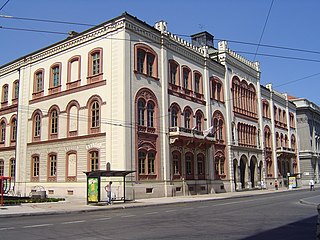
The Mansion of Miša Anastasijević is one of the most notable buildings in Belgrade, Serbia. It is the University of Belgrade's administration and governance building.
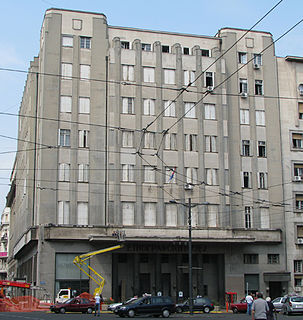
The Ethnographic Museum is a museum located in Belgrade, the capital of Serbia. It is one of the oldest museums in the Balkans. The Ethnographic Museum in Belgrade fulfills its mission together with the efforts of various stakeholders in the domain of presentation, revitalization and development of crafts in Serbia.

The House of the National Assembly of the Republic of Serbia is the seat of the National Assembly of Serbia. The building is on Nikola Pašić Square in downtown Belgrade, and is a landmark and tourist attraction. Between its completion in 1936 and 2006, it was the seat of the Parliament of Yugoslavia and the Parliament of Serbia and Montenegro.

Air Force Headquarters is the monumental edifice, situated at 12 Aviatic Square in Zemun, Belgrade, the capital of Serbia.
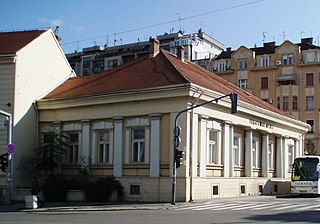
The Realka High School Building is located at the corner of 14 Uzun Mirkova Street and Tadeuša Košćuška Street, built between 1835 and 1840 in the style of classicism, most probably after the design of Franc Janke. Its social and historical value lies in the importance it had as the school building which attended and in which taught many important persons of 19th century Serbia: the teachers Stevan Todorović, Todor Mijušković, Petar Ubavkić, Mihajlo Valtrović, Đorđe Krstić, and students Kosta Glavinić, Milan Kapetanović, Svetozar Jovanović, Milorad Ruvidić, Danilo Vladisavljević, Nikola Nestorović...The building was named after the Belgrade Realka, located in it for a long time. The oldest preserved building in Belgrade was built in European style and is a unique example of classicism.
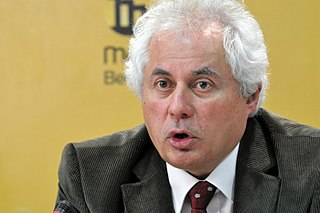
Ljubodrag Dimić is a Serbian historian, university professor and since 2012 member of Serbian Academy of Sciences and Arts. His primary fields of study are: history of former Yugoslavia, history of the Cold War, modern political, social and cultural history of Serbia and contemporary national history of Serbian people.

Elementary school at Dorćol is located in Belgrade, in 23, Cara Dušana Street, and it has the status of a cultural monument.

House of Milan Piroćanac is located in Belgrade, at the corner of Francuska and Simina streets, and it has the status of a cultural monument.

House of Dimitrije Živadinović is located in Belgrade, in the territory of the city municipality of Stari Grad. It was built in 1904 and represents immovable cultural property as a сultural monument.

Cinema "Balkan" is located in Belgrade at 16 Braće Jugovića Street. As the location of significant events in the history of Belgrade and Serbia, the "Balkan" Cinema represents a testimony to the cultural, urban and architectural development of Belgrade since the second half of the 19th century. It has had the status of a cultural monument since 1984.

The Old Telephone Exchange is a building located in Belgrade, Serbia, at 47 Kosovska Street. It was built according to the project by Branko Tanazević for the telephone exchange and is the first such building in Serbia. It was completed in 1908. The third floor was added later, after the First World War. The building is under state protection since 1981 as a cultural property of great importance. Conservation works were performed in 1988.
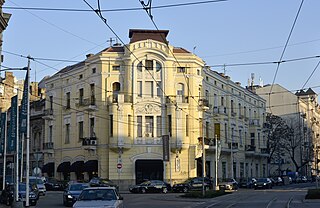
Vučo’s House on the Sava River is located in 61-61a, Karađorđeva Street, Belgrade, in the territory of the city municipality of Savski venac. It was built in 1908, and it represents an immovable cultural property as a сultural monument.

Military Hospital at Vračar is located in Belgrade, in the territory of the city municipality of Savski Venac, built in the period from 1904 to 1909. It represents an immovable cultural property as a cultural monument.

Nikola Spasić Endowment Building in Belgrade, 33, Knez Mihailova Street, was built in 1889 and it is a сultural monument of exceptional importance.

Building of Merchant Stamenković is located in Belgrade, in 41, Kralja Petra Street and it has the status of a cultural monument. The building of Merchant Stamenković was built in 1907 according to the project by the architects Аndra Stevanović and Nikola Nestorović. The building is a combination of academic conception and Art Nouveau decoration, so that is belongs to a group of residential buildings built before the First World War in Belgrade.

Seismological Institute Building (Serbian: Зграда Сеизмолошког завода, Zgrada Seizmološkog zavoda is located in Tašmajdan, park in Belgrade, the capital of Serbia. Built and adapted from 1908 to 1939, it was the first public building in this part of Belgrade and the first work of architect Momir Korunović, who later projected some of the most beautiful Belgrade buildings during the Interbellum and was nicknamed "Serbian Gaudi". It has been declared a cultural monument in 2007.
The May consultations were an underground gathering of the Central Committee (Politburo) of the Communist Party of Yugoslavia (CPY) and leaders of its regional branches held after World War II in Yugoslavia started, on the initiative of Josip Broz Tito in early May 1941 in Zagreb, at the time part of the so-called Independent State of Croatia.




















